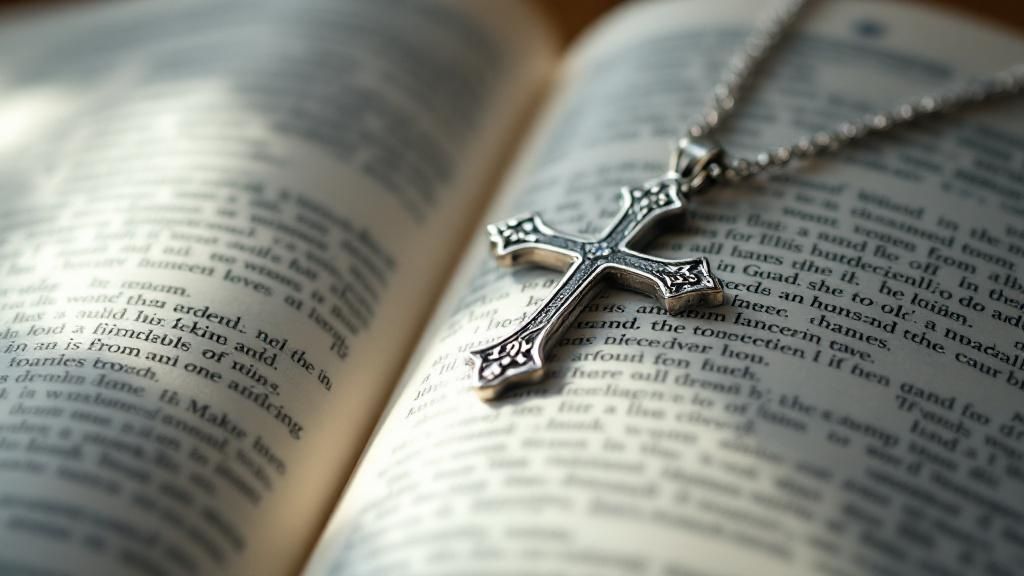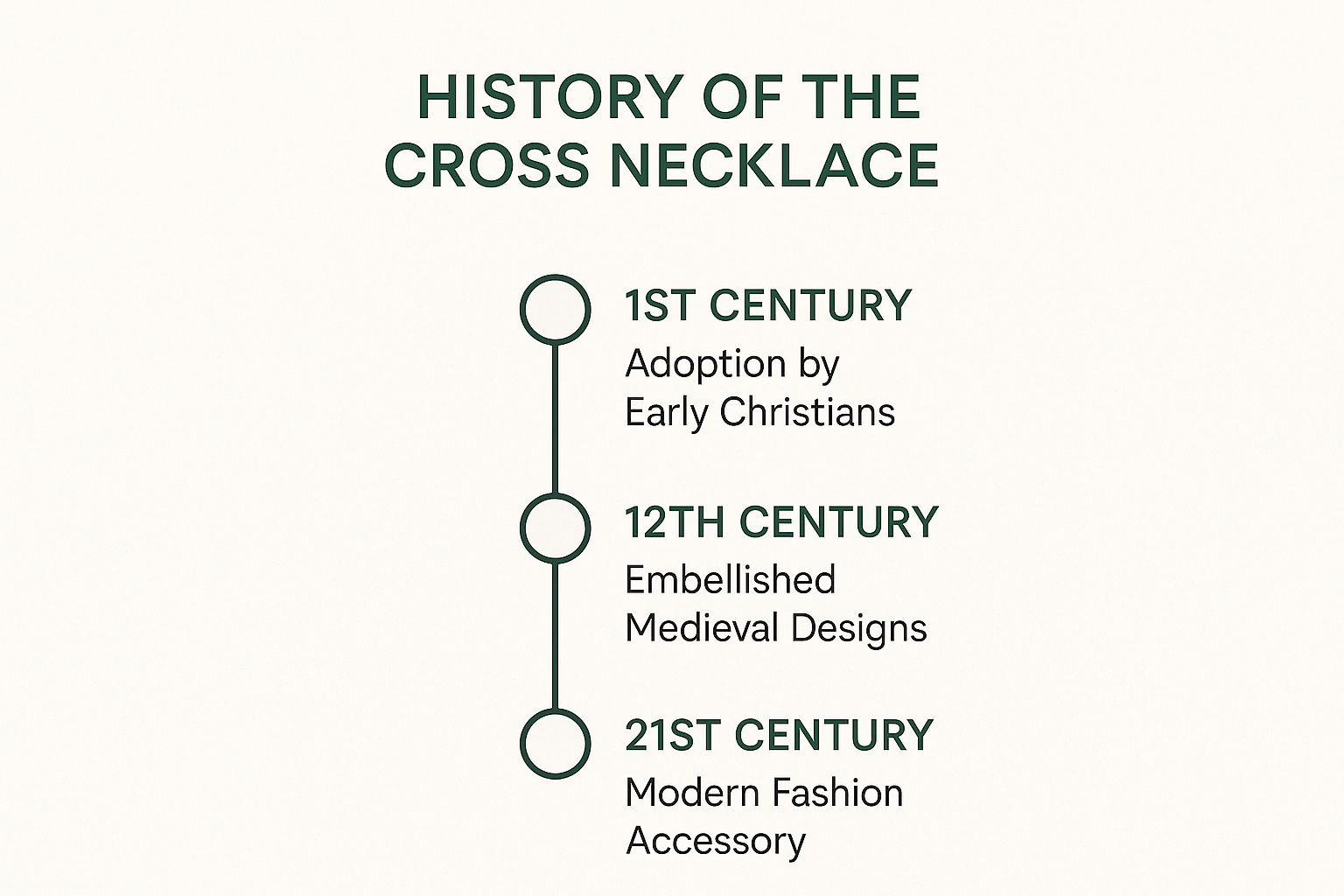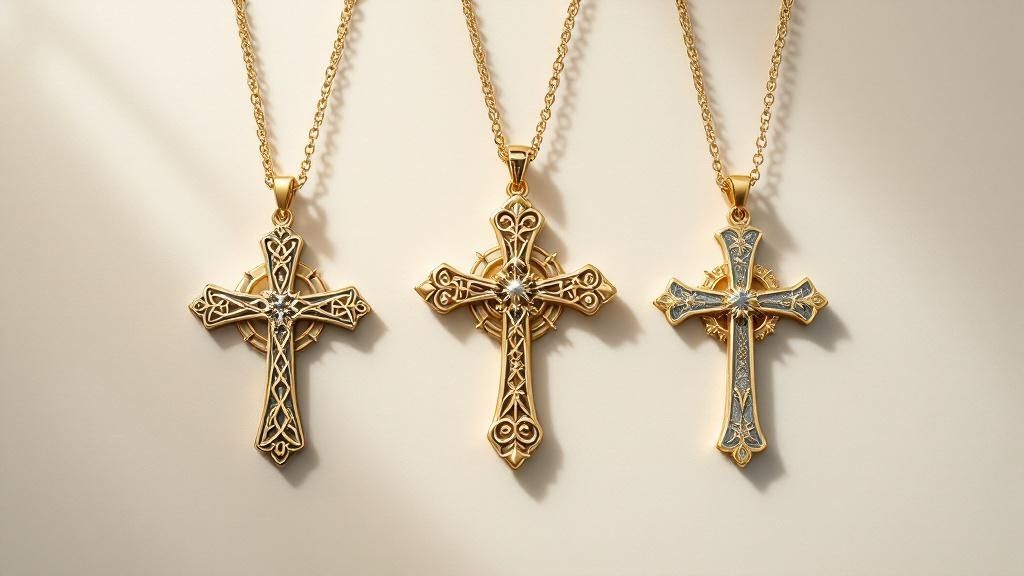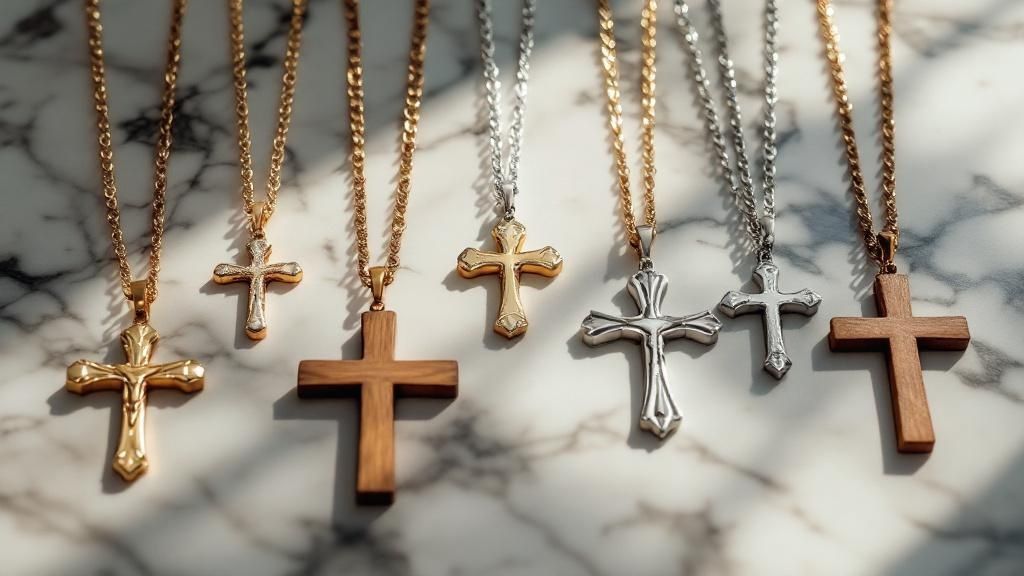- Continue Shopping
- Your Cart is Empty
Cross Necklace Meaning Unveiled
A cross necklace is so much more than a simple piece of jewelry; it's a powerful and personal statement. For countless people, it's a profound emblem of their faith, symbolizing sacrifice, resurrection, and a deeply felt connection to their Christian beliefs. The cross necklace meaning is a beautiful blend of the sacred and the personal.
The True Meaning Behind a Cross Necklace

While the symbol's roots are firmly planted in Christianity, its meaning has blossomed over time to include a wide array of personal expressions. Think of it as a single object with many chapters to its story, representing a mix of faith, heritage, and even fashion.
For a believer, the primary meaning is a direct and constant connection to their faith. It serves as a tangible, daily reminder of the core principles of Christianity.
- Sacrifice and Redemption: The cross immediately brings to mind Jesus's crucifixion, which is seen as the ultimate act of love and sacrifice for the salvation of humanity.
- Resurrection and Hope: Just as importantly, it symbolizes the resurrection. This offers a powerful message of hope, new beginnings, and the promise of victory over death.
- Personal Faith: Wearing a cross is a quiet yet visible declaration of one's beliefs and an outward sign of trust in a higher power.
More Than a Religious Icon
Beyond its spiritual heart, the cross necklace carries other significant meanings. It can be a nod to cultural heritage, like how a Celtic cross often represents Irish or Scottish roots. It also frequently serves as a poignant piece of memorial jewelry, worn to keep the memory of a cherished loved one close to the heart.
The cross can become a personal talisman.
The cross is a visual anchor to one's story. It can represent a journey of faith, a cherished memory, or a link to one's ancestors, making it one of the most versatile symbols in personal adornment.
For many, the necklace is a potent reminder of Christ's sacrifice, a theme often explored in a Good Friday reflection. Ultimately, the meaning is shaped by the person who wears it, blending rich history with their own unique story.
To put it simply, the meaning behind a cross necklace is multi-layered. Here’s a quick summary to help you understand the different contexts.
Cross Necklace Meanings at a Glance
| Context | Primary Meaning |
|---|---|
| Christian Faith | A reminder of Jesus's sacrifice, resurrection, and divine love. |
| Cultural Heritage | A symbol of one's roots, such as a Celtic or Coptic cross. |
| Memorial | Worn in loving memory of a departed family member or friend. |
| Personal Strength | A source of hope, comfort, and a reminder of personal endurance. |
| Fashion | A stylistic choice that appreciates the cross as a timeless design element. |
As you can see, a single symbol can speak volumes, telling a different story for every person who wears it.
The Historical Journey of the Cross
It’s hard to imagine now, but the cross began its life as a grim symbol of Roman execution. Its transformation into a deeply personal and cherished piece of jewelry is a truly fascinating story, one that really took off when the Roman Empire embraced Christianity in the 4th century.
In the beginning, these weren't accessories for everyone. The first cross necklaces were crafted from precious gold and studded with large gemstones. They were reserved almost exclusively for clergy, worn as a powerful emblem of high reverence and spiritual authority.
A Symbol of Comfort and Fashion
As Christianity's influence grew, so did the meaning behind the cross necklace. It began to shift from a purely clerical symbol to something much more personal. Simple versions carved from bone, stone, and wood started appearing, making it possible for ordinary people to hold a tangible piece of their faith close to their hearts.
During some of Europe's darkest chapters, like the Crusades and the Black Death pandemic that first struck in 1347, the cross necklace took on a new role. It became a profound source of spiritual comfort—a plea for divine protection against unimaginable hardship and a beacon of hope in a terrifying world.
The cross became a bridge between personal faith and public identity, evolving with every cultural shift. It moved from a sacred emblem to a source of comfort, a diplomatic token, and finally, a staple of high fashion.
The timeline below really brings this incredible journey to life, showing some key moments in its evolution.

As you can see, the cross went from a private symbol for early believers to an embellished public statement, and eventually, a mainstream fashion accessory loved by millions.
Its symbolic power even crossed cultural divides. European missionaries during the colonial era often presented silver crosses to Native American converts, marking their new faith. But the necklace’s place in society was truly cemented by royalty. A major turning point came in 1863 when King Frederick VII of Denmark gave a Dagmar cross to his daughter for her wedding.
This royal endorsement turned the cross necklace into a must-have trend, and its popularity soared across all social classes. From that point on, it has held a unique dual identity: a timeless icon of spirituality and an enduring statement of fashion. You can explore more about this generational history on henrimaillardet.com.
Exploring Different Cross Designs

While the familiar Latin cross is what most people picture, not all crosses tell the same story. The specific design of a cross can add powerful new layers to its meaning, reflecting distinct traditions, cultural histories, and deeply held beliefs.
Think of it as different dialects of the same language. Each design communicates a slightly different nuance, helping you find a piece that truly speaks to your personal story. Whether it's a connection to your faith, your heritage, or a specific spiritual idea, the shape matters. The variations aren't just in intricate metalwork; even simple small wooden cross pendants carry their own unique character.
These differences go far beyond aesthetics. Every shape is a symbol with its own history and message, inviting you to connect with a particular facet of faith or culture.
Common Cross Variations and Their Symbolism
Countless designs have emerged over the centuries, but a handful are especially well-known. Each one offers a different lens through which to view the core themes of faith, life, and heritage.
- The Latin Cross: With its longer descending arm, this is the most universally recognized symbol of Christianity. It’s a direct and powerful representation of the crucifixion of Jesus.
- The Greek Cross: This ancient design features four arms of equal length. It often symbolizes the church itself and the mission to spread the gospel to the four corners of the world.
- The Celtic Cross: Easily identified by the circle at its intersection, this cross is a proud emblem of Irish, Scottish, and Welsh heritage. That circle is rich with meaning, symbolizing eternity, God's endless love, and the promise of eternal life.
- St. Peter's Cross: An inverted Latin cross, this design might seem startling at first. It represents humility, based on the story that the Apostle Peter asked to be crucified upside down, feeling he was unworthy to die in the same manner as Christ.
The form a cross takes is not just an artistic choice—it's a narrative. It tells a story of a specific tradition, a moment in history, or a profound theological idea, all captured within a single shape.
Beyond these common variations, you might also see the ancient Egyptian Ankh, a looped cross symbolizing life, or the Tuareg Cross, a beautiful North African design often passed down from father to son as a symbol of love. Each design enriches the meaning of a cross necklace with its own unique legacy.
The Cross as a Symbol of Remembrance
Sometimes, a cross necklace isn't about a broad statement of faith or cultural identity. Its meaning is much more intimate: remembrance. It can be a profoundly personal tribute to a loved one who has passed, turning a simple accessory into a cherished memento.
Worn close to the heart, it becomes a tangible link to someone you've lost. In this sense, the cross represents both the ache of their absence and the quiet hope for a reunion in the afterlife—a core comfort in Christian faith.
This tradition of wearing a cross for remembrance really came into its own during the Victorian era. When Queen Victoria’s husband, Prince Albert, died in 1861, she began a very public, decades-long period of mourning that shaped everything from social etiquette to fashion.
The Victorian Embrace of Mourning Jewelry
During Queen Victoria's reign, mourning jewelry evolved into a beautiful and complex art form. Crosses were especially popular, becoming powerful symbols of both grief and memory. The Victorians had a unique way of blending deep religious conviction with raw personal emotion, and the cross was the perfect vessel for memorializing the departed.
The cross became a bridge between personal faith and societal values. It was an outward sign of both enduring belief and the emotional depth of loss, worn by people from all walks of life.
These weren't just simple crosses. Influenced by the Gothic revival movement, many were incredibly detailed, with intricate filigree and somber motifs. Jet, a deep black fossilized wood, was the hallmark material for these mourning pieces, lending them a dignified, solemn beauty. You can discover more insights about the history of the cross on fashion-era.com to see how these traditions evolved over time.
This practice is still very much alive today. Gifting a simple cross is a quiet, meaningful way to show sympathy and offer a tangible piece of comfort. It’s a way of saying, “they will not be forgotten,” while giving the person who is grieving a small source of strength. A delicate piece like a “May God Watch Over You” cross necklace beautifully captures this sentiment, serving as a constant prayer for a loved one’s peace.
The Cross as an Emblem of National Identity

Sometimes, a cross necklace carries a meaning that goes far beyond one person's faith or private memories. It can hold the story of an entire nation. In these cases, a specific cross becomes a powerful banner of cultural resilience and identity, shaped by centuries of history and perseverance.
When a sacred object transforms into a national emblem, it shows just how deeply faith and culture can become intertwined. The cross necklace then becomes a proud declaration of heritage, a wearable testament to survival.
The Enduring Legacy of the St. Nino Cross
A perfect example is the St. Nino Cross, the cherished national symbol of Georgia. You can spot it immediately by its unique design—the arms of the cross droop downwards in a distinctive way. This design isn't just an artistic choice; it's rooted in a legendary origin story.
According to tradition, the original cross was made from grapevine branches and bound together with the hair of St. Nino herself back in the 4th century.
For a nation, a cross can become more than an object of worship; it is a historical artifact that embodies the collective spirit of its people. It stands as a witness to their endurance, faith, and unbreakable will to survive.
Through one harrowing invasion after another, this cross became the very guardian of Georgian Christian identity. It was moved and hidden for centuries to protect it from being destroyed. The incredible story of its preservation—and its triumphant return to Georgia in 1802 by Tsar Alexander I—shows just how powerfully a religious symbol can embody a nation’s spirit. You can learn more about this and other historical crosses on meekbc.com.
Wearing a replica of a cross like this is a profound statement. It signifies a connection not just to one's faith, but to the very soul of a nation. It's a bit like how a sister’s cross necklace can symbolize an unbreakable personal bond, but on a grand, national scale.
Choosing a Cross Necklace That Tells Your Story
Now that you have a better sense of the rich history behind the cross, the fun part begins: finding the one that speaks directly to you. This isn't just about picking out a piece of jewelry. It's about finding a symbol that truly reflects your personal story, your faith, and what you want to carry with you each day.
The material you choose is the first chapter of that story. Gold, with its warm, enduring glow, has long been associated with the divine and things meant to last forever. Silver, on the other hand, often brings a sense of purity and clarity. If you feel more grounded and connected to nature, a simple wood or stone cross can represent that humility and earthiness beautifully.
Finding Your Perfect Fit and Style
Once you've thought about the material, consider the actual shape and size. A tiny, delicate cross resting close to your collarbone can be a quiet, personal reminder—something just for you. But maybe you want to make a more visible statement of your faith or heritage. In that case, a larger, more pronounced cross might feel just right.
How you wear it adds the finishing touch. Here are a few things to keep in mind:
- Wear It with Intention: In today's world, what matters most is the meaning you give it. Wear your cross with a sense of respect for its history and for your own personal connection to it.
- Layering Is Your Friend: A cross necklace looks incredible when layered. Try pairing it with other chains of different lengths and textures to create a look that’s uniquely yours.
- Consider a Modern Twist: You don't have to stick with tradition. Styles like the sideways cross offer a fresh, contemporary feel. A piece like a sterling silver sideways cross necklace for faith is a perfect example of blending modern style with deep personal meaning.
The right cross necklace should feel like it was made for you. It’s more than just an accessory; it’s a piece that should feel comfortable, meaningful, and deeply connected to your own sense of purpose.
When you choose with care and intention, your necklace becomes so much more than metal or stone. It transforms into a personal talisman—a beautiful way to wear your story for the world to see.
Got Questions About Cross Necklaces? Let's Clear Them Up.
It's completely normal to have questions when you're exploring jewelry with such deep roots. Figuring out the finer points of a cross necklace, from how to wear it to what a specific design means, helps you choose and wear your piece with confidence.
Let's dive into some of the questions I hear most often.
Is It Disrespectful to Wear a Cross If I'm Not Religious?
This is a common and very thoughtful question. While the cross is without a doubt the most recognized symbol of Christianity, it's also found its way into fashion and personal expression. People wear them to connect with their family heritage, as a memorial for a loved one, or simply because they admire the design.
Ultimately, it comes down to intent. If you choose to wear one for fashion, the key is to do so with respect for its profound spiritual significance to millions of believers. It's a personal choice, but a little mindfulness goes a long way.
What Does a Sideways Cross Necklace Mean?
The sideways cross is a much more modern interpretation. Think of it as a contemporary statement of faith.
Many people feel it symbolizes that Christ's work is finished—the cross has been laid to rest. It's often seen as a representation of our life here on Earth, caught between the divine and the human. It's not seen as disrespectful, just a fresh, personal way to express one's beliefs.
The core symbolism of the cross remains constant, but the material can add a personal layer. Gold might suggest divinity, silver purity, and wood humility, reflecting the wearer's unique story.
Does the Material of the Cross Change Its Meaning?
The short answer is no—the essential meaning of the cross doesn't change whether it's made of wood or platinum. The sacrifice and faith it represents are constant.
However, the material you choose can absolutely add a personal layer of meaning. For instance, a simple wooden cross might speak to humility and a connection to the natural world. A brilliant gold cross could symbolize divinity and glory, while polished silver might represent purity and grace. The material becomes part of your personal story with the piece.





